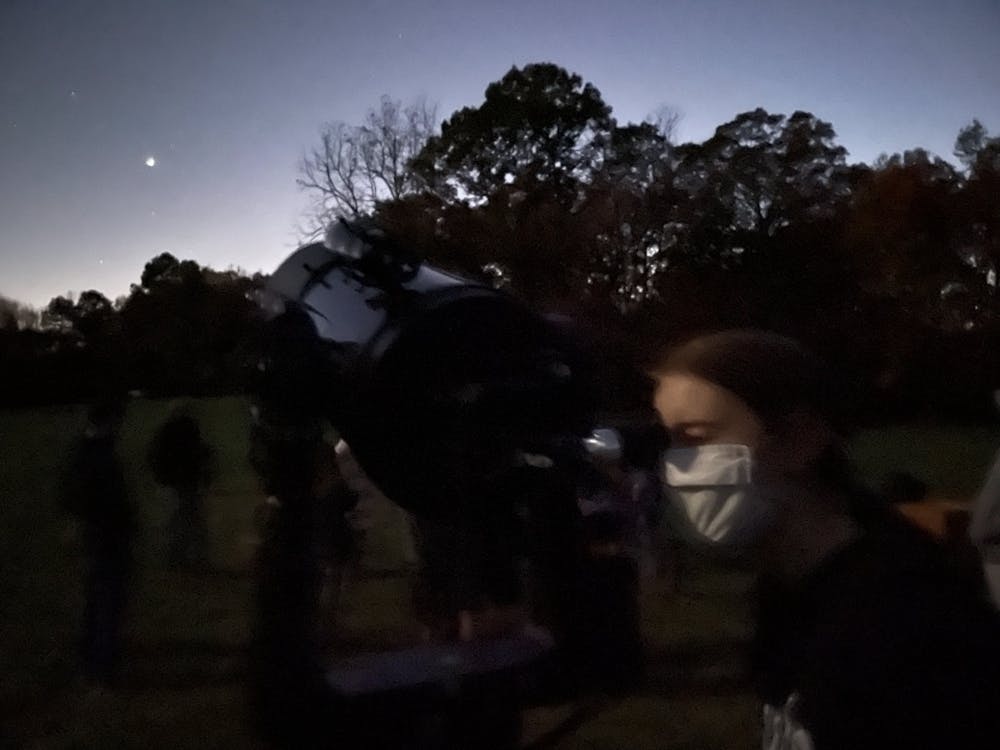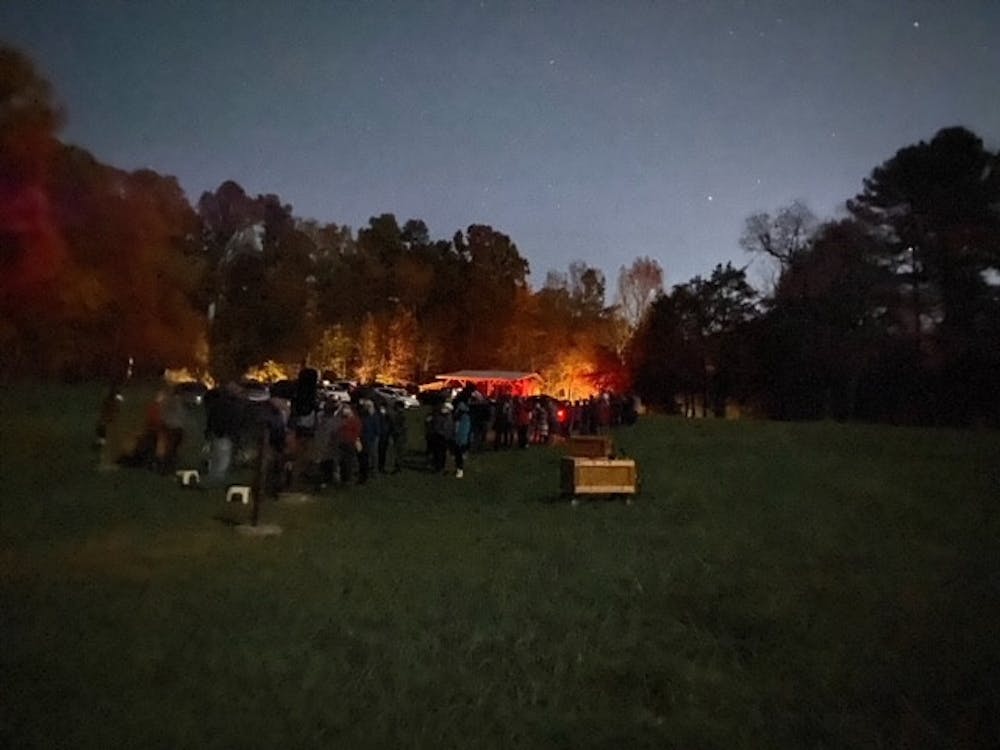It’s a clear November evening. The air is crisp and cool, and a half moon hangs high in the darkening sky—perfect conditions for stargazing.
So that’s exactly what my friend (and fellow features managing editor) Alison Korn and I do. We hop into a car and head to the Duke Teaching Observatory’s open house. It’s a quick five minute drive from West Campus.
Tucked inside the Duke Forest, the Duke Teaching Observatory is a little-known gem. The facility has had two missions since its founding in 2002: to enhance astronomy instruction at Duke by providing hands-on observation experiences and to provide a place where local students can meet with Duke faculty and students in an informal learning situation.
The observatory hosts open houses every week or two weeks, provided there are favorable weather conditions. Led by Duke Physics Lab Administrator Yuriy Bomze and Professor of Physics Ronen Plesser, students and community members from all over the Triangle can marvel at celestial objects up close.
Alison and I pull into a narrow dirt road, park on a patch of grass and get out of the car. Through the darkness, I can make out a shed to my right—for storing astronomy gear, perhaps—and a gentle downhill slope that gives way to a sprawling grassy field.
As Alison and I make our way down the hill, I can see Bomze setting up telescopes that are taller than his already towering frame. I also hear Plesser talking to a group of about 10 visitors. His gloved hand points to the brightest dot in the sky.
“Anybody recognize that star?” he asks. “That is Venus, the Evening Star, and also at other times the Morning Star. It's a planet that orbits near the sun, so we always see it near sunset or near sunrise.”
As Plesser speaks, Alison, the other visitors and I all line up behind the telescopes—three Meade LX200 GPS Schmidt-Cassegrains—and take turns observing the Evening Star. Standing beside me in line is senior Nita Yuchih, a Duke Kunshan University student. Tonight is her second visit to the observatory.
“I came here in September, and at that time it was still the fall sky. Now it’s the winter sky, so I'm coming to see if we got anything new,” Yuchih says. “The skies and stars are always charming and beautiful.”
My turn to view Venus comes shortly. As I peer into the telescope, I’m surprised to see that Venus doesn’t look like a dot up close. In fact, it’s more of a fuzzy, downward-facing crescent. This is because as Venus moves between Earth and the Sun, the sunlight’s angle changes and causes Venus to show phases similar to those of the Moon.
After everyone has seen Venus, Plesser introduces one of his favorite star clusters called the Dragonfly Cluster. “If you look there'll be two really bright stars. Those I consider to be the eyes. And if you start from the eyes, you should see a body and wings,” he says.

By now, the sky is completely dark. I look up and my breath catches—it looks as if someone took a brush and flecked the sky with sparkling paint.
It turns out we will have to wait for a bit before we can see the cluster through the telescope. A crowd of about 50 has gathered at the observatory. Long lines snake behind each of the telescopes.
Shan Collins and his small sons Jet and River stand in front of us. Collins’s wife works at Duke, and she received a newsletter that recommended the family visit the observatory.
“We're all nerds. We love space and science,” Collins says. “We thought [Jet and River] would like it, and secretly by proxy, I get to enjoy it too.”
Soon, it’s our turn to view the Dragonfly Cluster. Alison goes first. She closes one eye and looks into the telescope with the other.
“Oh, I can sort of see the dragonfly shape!” she says.
When I look, I see lots of bright dots, but I can’t seem to see the dragonfly that Alison and Plesser both see. To me, the stars look like an owl, or a fish. Perhaps these shapes are all subjective.
Saturn is up next. As Alison and I stand in line, Bomze quizzes us. “How thick do you think Saturn’s rings are?”
“One mile!” Alison guesses.
“50 miles!” I blurt out.
Bomze laughs. “It’s around 20 to 200 meters,” he says. That’s about 0.01 to 0.1 miles.
Bomze explains that the rings are held together by centrifugal force. The rings are very flat but also very wide, so without centrifugal force the rings would collapse inwards due to gravity, he says.
When it’s my turn to view, I peek into the telescope and let out an audible gasp. I see a ball of gas surrounded by large, gray elliptical rings. Though I’ve seen pictures of Saturn countless times, seeing it for real is an otherworldly experience.
I step back from the telescope to let a father hoist his daughter up to the lens. She holds her mouth in an open “O” as she takes Saturn in.
“It looks fake!” she says.
The very last object to see is the moon, because, as Plesser said earlier on in the night, “[The moon] will ruin your night vision. But it will be worth it.”
In front of me in line is Kevin Li, a postdoctoral from Duke Medical Center. On one hand, he holds a book titled “NightWatch: A Practical Guide to Viewing the Universe.” In the other, he holds a red LED flashlight as he pores over the book’s pages.
“I'm quite interested in astronomy,” Li says. “This book introduces you to basic [astronomy] knowledge and the equipment you should get.”
The line creeps forward, and Alison and I gradually reach the front. For the last time this evening, I lower my head and squint into the telescope’s lens.
The moon is a mix of grays and whites. The gray areas are smooth, while the white areas are mottled with craters. Today is a half moon, so the shadows from the moon’s dark side accentuate each crater’s depth.
Bomze explains this in more scientific terms. Interesting things happen in between the terminator line, he says, which is the line that divides day and night on the moon. “The full moon just looks flat. The terminator line makes the moon look three-dimensional.”
It takes a long time for Alison and I to peel our eyes away from the telescope lens, but we finally do. As Alison and I head back up the hill to the car, I recall all that I’ve seen tonight—Venus’s bright crescent, the glittering Dragonfly Cluster, Jupiter’s red bands, Saturn’s ethereal rings and the Moon’s cratered surface. There’s no question that Alison and I will be back next semester to view the spring sky.
Get The Chronicle straight to your inbox
Signup for our weekly newsletter. Cancel at any time.

Katie Tan is a Trinity senior and digital strategy director of The Chronicle's 119th volume. She was previously managing editor for Volume 118.

